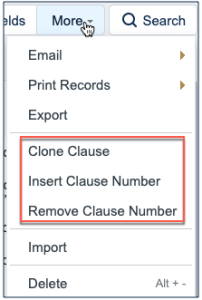...
- Clause Type - Categorizing clauses makes it possible to filter them if you want to allow users to select from alternative clauses for a specific section of the contract, for instance the termination provisions, or the indemnification provisions.
- Status - Statuses of Active, Pending Approval, Retired, Replaced or Rejected can be used to filter available clauses and to indicate where they are in any approval workflow.
- Default Risk Rating - indicates the level of risk for this clause type on a scale of 0 (no risk) to 1 (highest risk).
- Clause Priority - is used to sort a drop-down list of clauses that may be filtered and presented to the user. If you have four variants for indemnification, for instance, and you want to display them in a particular order, you would set the Clause Priority with the appropriate values (1 for the highest to appear on the list).
- Approval Team - can be used to define the approval team with responsibility for updating this clause.
- Clause Owner - can be used to indicate a specific person responsible for changes to the clause.
- Language - allows you to select the language of the clause text
- Has Multiple Languages - selecting Yes displays a related table where you can link multiple child clauses in other languages.
Clause Usage - indicates how a clause may be used and can also be used as a filter to display optional clauses or user-selected clauses for users to choose, as opposed to conditional clauses that will be populated into the template automatically based on some predefined condition.
- Usage Details - this is a text description field to provide details on where and how this clause should be used. It is purely informational.
- Used by Print Templates - allows you to link a clause to the print templates that will use it, to have an audit trail of which templates will or should be updated if the clause language changes.
Action Buttons on the Action Bar
The action bar above the clause table has three special options under the Actions More drop-down. These options are Clone Clause, Insert Clause Number, and Remove Clause Number
- Clone Clause can be used with one or more clauses to clone them and create a copy. The copies will map most of the field values and will add the date cloned to the clause title. This makes it easy to create copies of a clause for some purpose such as revision, and then to edit the resulting clause.
- Insert Clause Number adds MS Word code that results in auto-numbering in front of that clause when the clause is used in a print template. This is one method of managing clause numbering within your contracts. See below for more details.
- Remove Clause Number removes the MS Word code for auto-numbering from the selected clause(s). This is handy if you change your mind about the method to use for numbering.
...
For the same contract types, the user can also select clauses that have been defined in the Print Template Clauses table using the Select Optional Clause(s) field. The user can select the clauses he wants to add, and when the document is generated, those clauses will be added under the section called Additional Terms. This field is only visible if the Print Template record has a value of Yes in the "Has Optional Clauses" field. For more information on Print Template Clause records, visit Print Document Template Clauses Table.
These basic approaches can be expanded upon for a given implementation, depending on the needs of your company.
...




